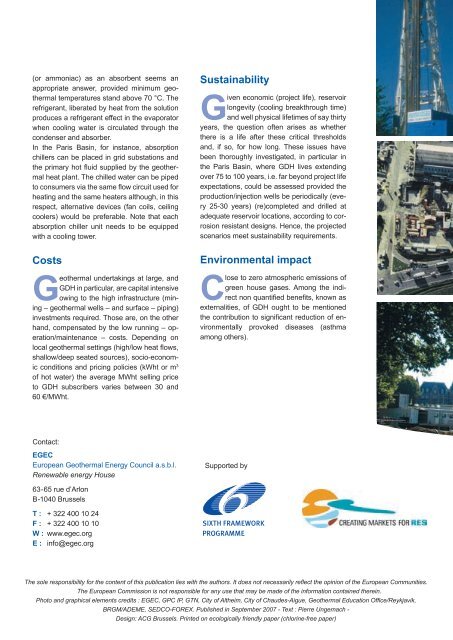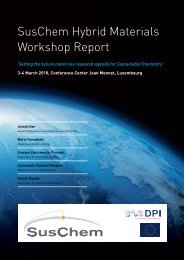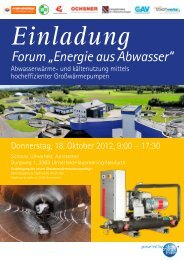GEothErmal DIStrICt hEatING - EGEC
GEothErmal DIStrICt hEatING - EGEC
GEothErmal DIStrICt hEatING - EGEC
You also want an ePaper? Increase the reach of your titles
YUMPU automatically turns print PDFs into web optimized ePapers that Google loves.
(or ammoniac) as an absorbent seems anappropriate answer, provided minimum geothermaltemperatures stand above 70 °C. Therefrigerant, liberated by heat from the solutionproduces a refrigerant effect in the evaporatorwhen cooling water is circulated through thecondenser and absorber.In the Paris Basin, for instance, absorptionchillers can be placed in grid substations andthe primary hot fluid supplied by the geothermalheat plant. The chilled water can be pipedto consumers via the same flow circuit used forheating and the same heaters although, in thisrespect, alternative devices (fan coils, ceilingcoolers) would be preferable. Note that eachabsorption chiller unit needs to be equippedwith a cooling tower.SustainabilityGiven economic (project life), reservoirlongevity (cooling breakthrough time)and well physical lifetimes of say thirtyyears, the question often arises as whetherthere is a life after these critical thresholdsand, if so, for how long. These issues havebeen thoroughly investigated, in particular inthe Paris Basin, where GDH lives extendingover 75 to 100 years, i.e. far beyond project lifeexpectations, could be assessed provided theproduction/injection wells be periodically (every25-30 years) (re)completed and drilled atadequate reservoir locations, according to corrosionresistant designs. Hence, the projectedscenarios meet sustainability requirements.CostsGeothermal undertakings at large, andGDH in particular, are capital intensiveowing to the high infrastructure (mining– geothermal wells – and surface – piping)investments required. Those are, on the otherhand, compensated by the low running – operation/maintenance– costs. Depending onlocal geothermal settings (high/low heat flows,shallow/deep seated sources), socio-economicconditions and pricing policies (kWht or m 3of hot water) the average MWht selling priceto GDH subscribers varies between 30 and60 €/MWht.Environmental impactClose to zero atmospheric emissions ofgreen house gases. Among the indirectnon quantified benefits, known asexternalities, of GDH ought to be mentionedthe contribution to significant reduction of environmentallyprovoked diseases (asthmaamong others).Contact:<strong>EGEC</strong>European Geothermal Energy Council a.s.b.l.Renewable energy HouseSupported by63-65 rue d’ArlonB-1040 BrusselsT : + 322 400 10 24F : + 322 400 10 10W : www.egec.orgE : info@egec.orgThe sole responsibility for the content of this publication lies with the authors. It does not necessarily reflect the opinion of the European Communities.The European Commission is not responsible for any use that may be made of the information contained therein.Photo and graphical elements credits : <strong>EGEC</strong>, GPC IP, GTN, City of Altheim, City of Chaudes-Aigue, Geothermal Education Office/Reykjavik,BRGM/ADEME, SEDCO-FOREX. Published in September 2007 - Text : Pierre Ungemach -Design: ACG Brussels. Printed on ecologically friendly paper (chlorine-free paper)












